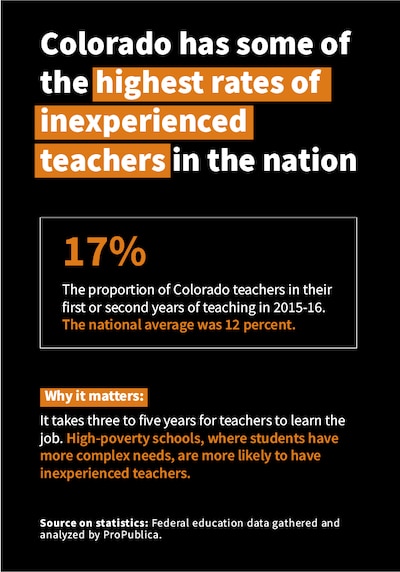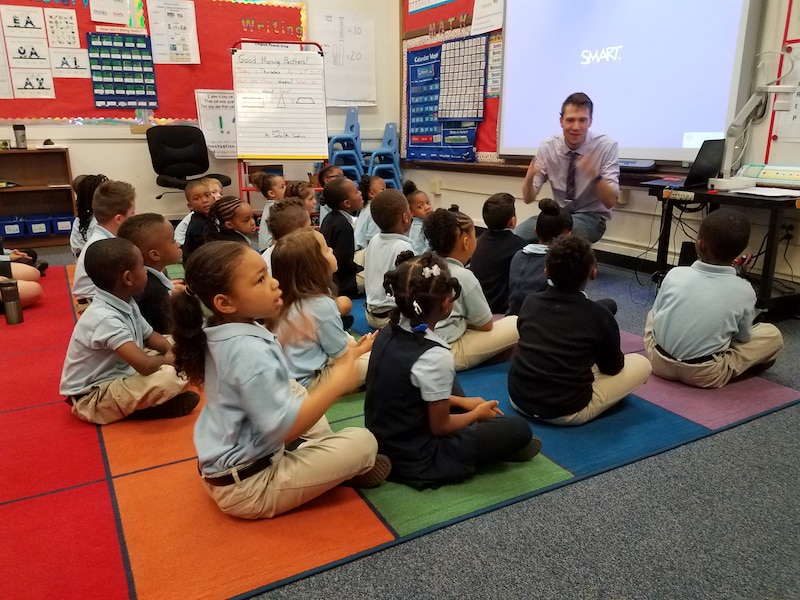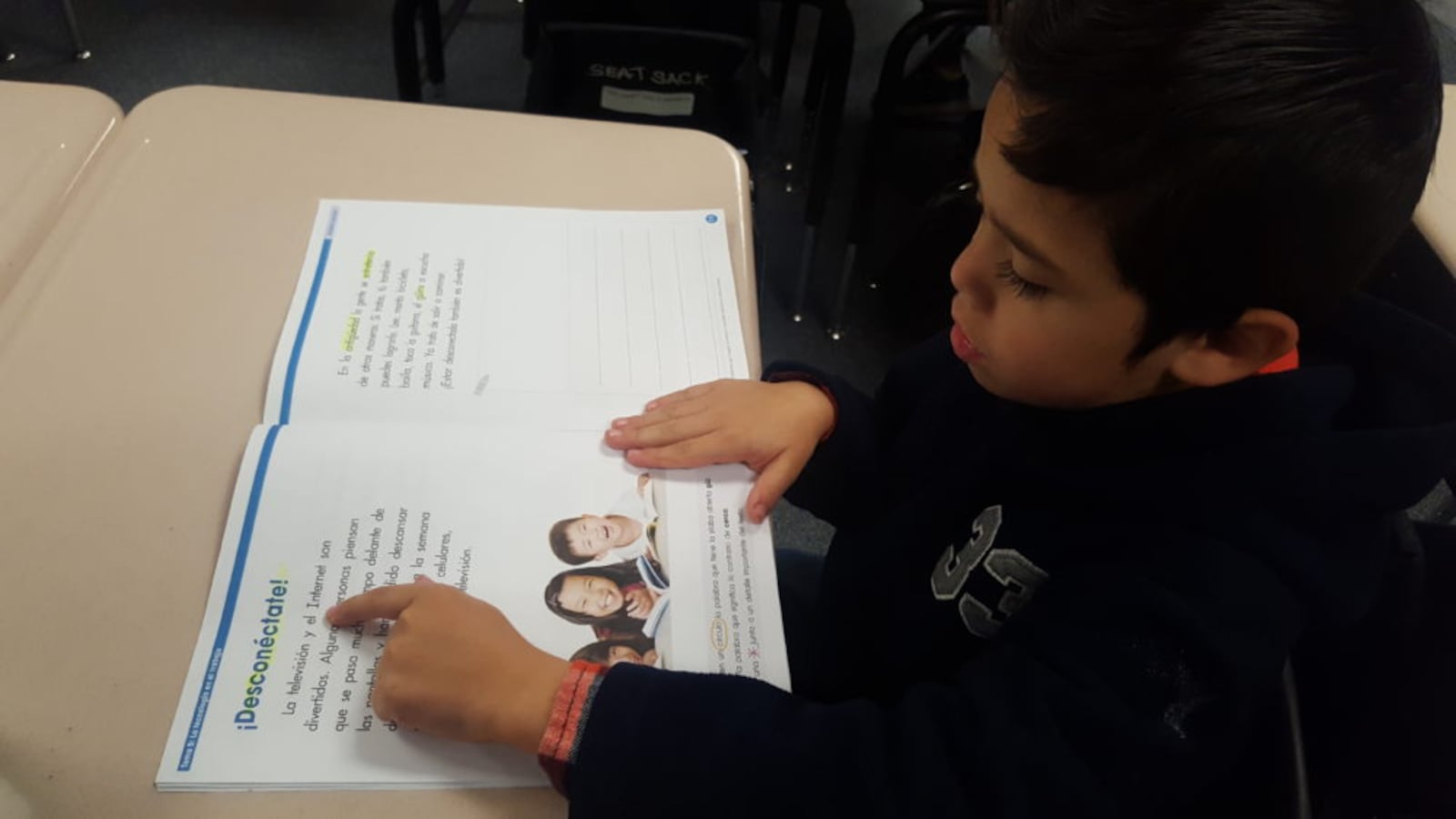This story is part of a partnership between Chalkbeat and the nonprofit investigative news organization ProPublica. Using federal data from Miseducation, an interactive database built by ProPublica, we are publishing a series of stories exploring inequities in education at the local level.
Koli Jamerson’s residency program gave her tools that she uses every day as a teacher, ideas for developing engaging lessons and for working with English language learners.
But it didn’t teach her how to help a student who explodes in anger because the police were at her house the night before on a domestic violence call or who cries all day because she doesn’t know where she’ll sleep that night.
Jamerson, now in her third year of teaching first grade at Altura Elementary in the Aurora school district, is still standing. She remains committed to her profession in large part due to the help of veteran teachers on her team, who provided advice as she found her footing those first couple of years.
“It helps keep things in perspective,” Jamerson said of her conversations with more experienced educators. “Otherwise, I would have been talking to a bunch of other teachers who were also drowning, and we would have drowned together.”

It’s getting hard for new teachers in Colorado to find those support systems, since the percentage of Colorado’s teachers in their first or second year in the classroom is among the highest in the nation. In 2015-16, the most recent year for which federal data is available, 17 percent of Colorado teachers were new to the classroom, compared with 12 percent nationally. Only Tennessee, Arizona, and Washington, D.C., rank higher. As recently as 2011, less than 11 percent of Colorado’s teachers were new to the classroom.
This information comes from a new interactive database from the investigative news organization ProPublica. It draws on data collected by the U.S. Department of Education’s Office of Civil Rights and for the first time allows parents to easily search their school and district and compare it with others in the region.
The rates of inexperienced teachers are even higher in certain rural districts and in districts where lots of students come from low-income families and face more challenges. Those districts also often have high numbers of students of color. In contrast, whiter, more affluent suburban districts tend to have low rates of inexperienced teachers.
And those numbers have significant ramifications for Colorado’s students: New teachers can bring energy and innovation to the classroom, and some, especially those with support and guidance, manage to thrive early on. But students with inexperienced teachers tend to have lower test scores on average, according to numerous studies, and new teachers often get lower scores in classroom management from their principals.
Most teachers will readily admit it takes several years to get your bearings in a profession for which no amount of classroom learning can fully prepare you.
“In reality, you get second grade one time, you get third grade one time, as a kid,” said David Singer, founder of Denver’s University Prep charter network, which has shown impressive test results even with plenty of relatively inexperienced teachers. “You deserve an excellent educator.”
Chalkbeat reviewed more recent state data that follows the typical federal definition of “inexperienced teachers” — teachers with less than three full years of classroom experience — and found that the broad trends remain true and in many cases are even more severe than they appear in the federal data. Statewide, one in four Colorado teachers was classified as inexperienced. Last school year, 31 percent of Denver Public Schools teachers were in their first three years on the job, compared with just 7 percent of teachers in the more affluent Boulder Valley School District.
The Adams 14 district, based in the working-class suburb of Commerce City, is one of the lowest-performing in the state. Last year, 45 percent of teachers there were considered inexperienced, compared with 8 percent in the south suburban Littleton district.
In districts with so many new teachers, it becomes inevitable that students there will encounter educators who haven’t yet reached their prime.
“When a teacher is new to the profession, as with any profession, they’re not as effective,” said Allison Atteberry, an assistant professor in the research and evaluation methods program at the University of Colorado’s School of Education. “There’s a really steep learning curve in those first years. That can’t really be avoided. But if there are more of those teachers, then more students will be exposed to those teachers. And if you have districts with more at-risk students, that has major equity implications.”
Atteberry said the numbers don’t surprise her, and they reflect a perfect storm in the state’s teacher corps. Colorado has experienced rapid population growth, increasing the demand for teachers, at the same time that experienced teachers are retiring or changing careers. That means more new teachers in Colorado classrooms, even as fewer students are entering teacher preparation programs.
Colorado’s low teacher pay exacerbates retention problems. Colorado ranks 30th for teacher pay, and when those salaries are adjusted for cost of living, it falls to 44th. The competitiveness of its teacher salaries is the lowest in the nation, meaning that people who go into teaching take a bigger salary hit compared to their peers with similar levels of education. Nationally, 1 in 10 teachers will leave the profession after their first year, and many more never reach the five-year mark.
Districts around the state are asking voters to raise taxes this November in part to raise teacher pay. Better pay for educators is also a major part of the campaign for Amendment 73, a $1.6 billion statewide tax increase for schools that appears on the ballot. But Colorado voters have so far been reluctant to raise statewide taxes for schools, and critics say there is no guarantee the money will make it into teachers’ paychecks.
Atteberry said raising pay would help mitigate these trends. Beyond that, there isn’t a lot of solid research on the best ways to keep teachers in the classroom, she said, but coaching and support from other teachers can make a difference. Denver is trying a new program to ease the transition for novice teachers with more time spent observing and learning from veterans before getting sole responsibility for a classroom. But just as with teacher salaries, providing adequate coaching is expensive. And the more newcomers there are, the harder it is provide meaningful support to novices.
Denver metro area inexperienced teachers
Source: Colorado Department of Education, 2017-18 school year
This year, for the first time, Annalee Peterson has her own fifth-grade classroom in Columbia Elementary in Colorado Springs, where a large portion of the students are homeless or face other challenges. Before starting an alternative certification process, she ran reading groups as a paraprofessional in the same building for four years. And years before that, she dropped out of a Teach for America placement in a Newark high school where she felt alone and unsupported.
Peterson said her certification program includes intensive classroom observation and feedback that has been invaluable as she made the transition from para to teacher. She also has a trusting relationship with her building principal, who encouraged her to become a teacher.
“I think every new teacher should have a mentor,” she said. “I see other teachers come in, and they don’t have it.”
Peterson said she also benefits from her school’s skilled full-time counselor, something many Colorado schools don’t have.
“If we have a kid with a fair amount of trauma, and they get triggered, they have someone they can go talk to,” she said. “And that’s a huge help. They are getting their emotional needs met, and when they come back to the classroom, they’re ready to work and ready to focus.”
The Adams 14 school district, which has spent eight years on a state watchlist due to its low-performing schools, has the highest rate of inexperienced teachers in the Denver metro area. The 7,000-student district has experienced a lot of turnover not just at the classroom level, but at the highest tiers of leadership.
With an urgent need to improve school performance, Mark Langston, the district’s new manager of educator effectiveness, tries to put a positive face on the large number of new educators that arrive each year.
“I’d rather have a phenomenal teacher for one year, than a bad teacher for many years,” Langston said. “Strong systems have a nice blend of experience.”
At the same time, he’s trying to improve the support those new teachers receive by making changes to the district’s five-day induction program to better meet their individual needs. The thinking is that a 40-year-old switching careers after running a business for 20 years might need different training from a 22-year-old recent college graduate. He’s also trying to match new teachers with mentors earlier in the school year.
But sometimes there aren’t enough mentors or he’s had to make exceptions to allow less experienced teachers to become mentors.
“They are mentoring each other,” said Barb McDowell, president of the Adams 14 teachers union, who says the churn takes a toll on teacher and student morale. “There are no veteran teachers there to help.”
Kevin Clark, a senior at Adams City High, said he always felt supported by his teachers in the district, but very few of them are still there as he enters his final year.
“For the seniors, it’s been rough,” he said. “We really value our support systems. The new teachers are trying to adjust and get their footing, but just because you send in a batch of new teachers, doesn’t mean everything is fine.”
The Denver schools with the highest percentages of inexperienced teachers in 2015-16 include a number of alternative high schools, high-poverty district-run schools, and charter schools. Some of the charter schools are part of high-performing networks whose students do well on state tests.
One of them is University Prep. The homegrown Denver network has two elementary schools, one of which posted the most academic progress in Colorado on state math tests in 2017. But in 2015, the network had just one school — and 42 percent of the teachers there were in their first or second year of teaching, according to the federal data.
At University Prep, some first-year teachers have taken part in a teacher residency program or in a program that has college students work as paraprofessionals while earning their degrees.
“When you think about that individual exiting their undergraduate [education] having spent four years in a building with master teachers, getting all the supports they need to grow, they’re ready to teach on Day 1,” said Singer, the network’s founder.

Even so, the network provides its first-year teachers with extra support, he said, such as real-time coaching in the classroom, opportunities to observe more experienced teachers, and help with how to plan a lesson or conduct a parent-teacher conference.
Atteberry said successful charter schools with high rates of inexperienced teachers may be doing something different in the hiring process, looking for “spark teachers who really want to make a difference.”
The high rates of new teachers at some charter schools raise questions, though, about how sustainable the work environment is, and some of these same “spark” teachers may never intend to make a lifelong career of it and instead move on to other challenges. Asked about turnover, Singer said some University Prep teachers have left to pursue careers in medicine and law.
Denver metro area data show another exception to the trend in Douglas County. It’s an affluent and sprawling district southwest of Denver where just 12 percent of students get subsidized lunches, a proxy for poverty. But in 2015-16, 31 percent of teachers were in their first or second year in the classroom, and in 2017-18, 39 percent had less than three years experience.
Kallie Leyba, president of the Douglas County Federation, the teachers union there, said Douglas used to be a “destination district” that teachers aspired to work for. But political upheaval, the election of a conservative school board that has since been replaced, and a “market rate” pay structure that remains have caused experienced teachers to leave in droves — some for much higher salaries in nearby Cherry Creek schools.
The Douglas County pay scale means that teachers with the same amount of experience might make very different salaries. Leyba herself faced the prospect of a lower ceiling on her salary when her building principal asked her to switch from a first grade to a second grade classroom because first-grade teachers are more in demand.
“Even though I knew this was a crazy system, it really hurt to feel like my value had gone down in the eyes of my principal,” she said.
What could Colorado do to get more of today’s inexperienced teachers to become tomorrow’s veteran educators?
Money is a big part of the answer. As it stands, Colorado teachers can earn significantly more money by moving to another state, and with teacher salaries less competitive here than elsewhere, teachers also look to other professions that offer less stress along with better pay.
“The No. 1 thing we should do is increase the prestige and value of teachers in society, and the way we signal that in our society is through salary and compensation,” Atteberry said. “That has a huge influence on who goes into the profession and on who stays.
“This is not an easy change because it costs a lot of money, and it also requires us to change how we think about teachers, but it is the policy that would be most effective.”
Chalkbeat reporters Melanie Asmar and Yesenia Robles contributed reporting to this story.

